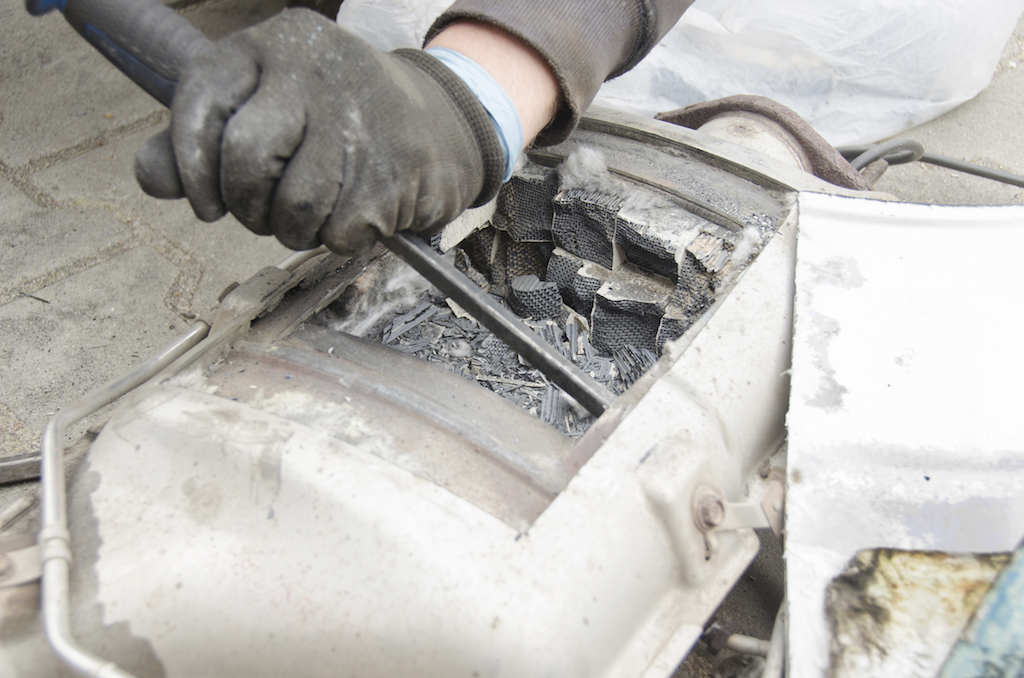Switching off the diesel particulate filter
This article describes the deactivation of diesel particulate filters (DPF) in diesel engines. This technique is generally also called DPF delete or DPF off. In some regions the DPF is also called FAP.

Description
The exhaust gases of newer vehicles are causing ever finer soot particles. This is why a technology that can filter these particles from the exhaust gas was required, especially for inner cities. Unfortunately, the problem with many diesel particulate filters is that the first generation filters did not pay attention to the particle size, but to the amount of filtered exhaust gas. The actually harmful fine particles were not filtered out with these filters.
However, visible soot in vehicles is less of a health hazard because these particles cannot penetrate deep enough into the lungs.
The soot collected in the DPF must be burned regularly. A small amount of ash remains in the diesel particulate filter, which accumulates in the diesel particulate filter over time and blocks up the DPF. After that, the DPF must be replaced at high cost. In the case of older filters in particular, the question is whether this measure makes sense, because these filters do not remove the fine dust that is hazardous to health.
Another problem with the DPF is that the combustion process only takes place at medium-high temperatures, at which chemical transformations take place, which in turn can lead to toxic substances.
The regeneration of the diesel particulate filter is done by burning the accumulated particles. This is necessary because the accumulation of particles blocks the filter and increases the exhaust back pressure, which reduces the performance of the vehicle.
Diesel particulate filters are more complex than catalysts and more expensive. For the process of the combustion of the accumulated particles a complex technology is necessary which brings an increased maintenance expenditure, increased consumption and increased costs with itself. Measurements have also shown that certain particle sizes are not sufficiently filtered.
Our DPF delete service removes the DPF system from the vehicle's engine control unit. After removal, the vehicle drives like a system with DPF, without error messages and without the engine indicator light lighting up.
Deactivating the DPF system is intended exclusively for use off public roads. Report any changes to the competent authorities. Comply with the laws in your country.
However, visible soot in vehicles is less of a health hazard because these particles cannot penetrate deep enough into the lungs.
The soot collected in the DPF must be burned regularly. A small amount of ash remains in the diesel particulate filter, which accumulates in the diesel particulate filter over time and blocks up the DPF. After that, the DPF must be replaced at high cost. In the case of older filters in particular, the question is whether this measure makes sense, because these filters do not remove the fine dust that is hazardous to health.
Another problem with the DPF is that the combustion process only takes place at medium-high temperatures, at which chemical transformations take place, which in turn can lead to toxic substances.
The regeneration of the diesel particulate filter is done by burning the accumulated particles. This is necessary because the accumulation of particles blocks the filter and increases the exhaust back pressure, which reduces the performance of the vehicle.
Diesel particulate filters are more complex than catalysts and more expensive. For the process of the combustion of the accumulated particles a complex technology is necessary which brings an increased maintenance expenditure, increased consumption and increased costs with itself. Measurements have also shown that certain particle sizes are not sufficiently filtered.
Our DPF delete service removes the DPF system from the vehicle's engine control unit. After removal, the vehicle drives like a system with DPF, without error messages and without the engine indicator light lighting up.
Deactivating the DPF system is intended exclusively for use off public roads. Report any changes to the competent authorities. Comply with the laws in your country.
How does it work?
To use the ECUWare service, you need the binary file from the vehicle's engine control unit. There are different manufacturers, such as Alientech, Flashtec, AMT Cartech, Dimsport, FG Technology, Magicmotorsport, PCMFlash, etc. who offer this tool for reading and writing the ECU.
Not every tool is suitable for every ECU, in case of doubt the manufacturer should be asked whether the ECU to be processed is supported. This tool is then used to read out the engine control unit and save it as a file.
Then upload this file to ECUWare. The DPF functionality is then removed from the file. As soon as the file is ready for download, you will receive an e-mail message containing a link to the file for download.
You download the file and then load this file back into the ECU. This completes the process.
Not every tool is suitable for every ECU, in case of doubt the manufacturer should be asked whether the ECU to be processed is supported. This tool is then used to read out the engine control unit and save it as a file.
Then upload this file to ECUWare. The DPF functionality is then removed from the file. As soon as the file is ready for download, you will receive an e-mail message containing a link to the file for download.
You download the file and then load this file back into the ECU. This completes the process.
ECUWare.com
is a project of
Sales Opening Hours CET
Monday - Friday
07:00 AM - 10:00 PM
Saturday
07:00 AM - 02:00 PM
Sunday
Closed
Technical Support Opening Hours CET
Monday - Friday
09:30 AM - 01:00 PM
02:00 PM - 06:00 PM
02:00 PM - 06:00 PM

